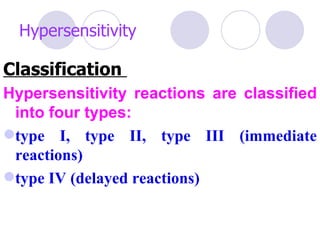
Hypersensitivity
- 1. Hypersensitivity Classification Hypersensitivity reactions are classified into four types: type I, type II, type III (immediate reactions) type IV (delayed reactions)
- 2. Type I Hypersensitivity Allergens Inhalants: Pollen grains, Fungal allergens Injectants: drugs Contact: Antiseptic spray
- 3. Type I hypersensitivity is known as immediate or hypersensitivity. The reaction may involve: ■ Skin (urticaria and eczema), ■ Eyes (conjunctivitis), ■ Nasopharynx (rhinorrhea, rhinitis), ■ Bronchopulmonary tissues (asthma) ■ Gastrointestinal tract (gastroenteritis).
- 4. ■ The mechanism of reaction involves production of IgE, in response to certain antigens (allergens). ■ IgE has very high affinity for its receptor on mast cells and basophils. ■ A subsequent exposure to the same allergen cross links the cell-bound IgE and triggers the release of various active substances.
- 5. Cross-linking of IgE Fc-receptor is important in mast cell triggering. Mast cell degranulation is preceded by increased Ca++ influx, which is a crucial process.
- 8. Mediators of Immediate Hypersensitivity Preformed mediators in granules: Hypersensitivity Table 1 Mediators of I bronchoconstriction, mucus secretion, histamine vasodilatation, vascular permeability tryptase proteolysis ECF-A attract eosinophil and neutrophils Newly formed mediators: leukotriene B4 basophil attractant leukotrieneC4, same as histamine ( 1000x more potent) D4 prostaglandins
- 9. Diagnostic tests for immediate hypersensitivity ■Skin (prick and intradermal) tests. ■Measurement of Total IgE and specific IgE antibodies: measured by ELISA.
- 10. Treatment A- Avoidance of exposure. B- Symptomatic treatment. C- Immunotherapy
- 11. Symptomatic treatment 1-Antihistamines which block histamine receptors. 2-Chromolyn sodium inhibits mast cell degranulation, by inhibiting Ca++ influx. 3-Late onset allergic symptoms, particularly bronchoconstriction which is mediated by leukotrienes, are treated with leukotriene receptor blockers or inhibitors of the cyclooxygenase. 4-Symptomatic, although short term, relief from bronchoconstriction is provided by bronchodilators (inhalants).
- 12. Type II hypersensitivity ■ Also known as cytotoxic hypersensitivity and may affect a variety of organs and tissues. ■ The antigens are normally endogenous, although exogenous chemicals (haptens) which can attach to cell membranes can also lead to type II hypersensitivity. ■ Primarily mediated by IgM or IgG classes → ◘Complement mediated lysis. ◘Phagocytes and Killer cells may also play a role (ADCC).
- 14. Types A- RBCs lysis: 1- Incompatible blood transfusion. 2- Erythroblastosis faetalis: 3- Autoimmune hemolytic disease. B- WBCs lysis: 1- Granulocytopenia. 2- S.L.E. C- Platelet destruction:
- 15. Type III Hypersensitivity (immune (complex hypersensitivity ■ It is mediated by soluble immune complexes. They are mostly of the IgG, although IgM may also be involved. ■ The antigen may be: ■ exogenous (chronic bacterial, viral or parasitic infections). ■ endogenous (non-organ specific autoimmunity: e.g. (SLE).
- 16. Mehanism ■ The Ag is soluble and not attached to the organ involved. ■ Soluble Ag-antibody complexes which pentrate the enothelium of blood vessel and deposited on the vascular basement membrane. ■ This will stimulate the complement and chemotactic factors like C5a is released which attract neutrophils which infitrate the area and release lysosomal enzymes leading to destruction of the basement membrane.
- 17. Types :Arthus reaction -1 :Serum sickness -2 :Hypersensitivity pneumonitis -3 :Posstreptococcal glomerulonephritis -4 Autoimmune disease: RA , SLE -5
- 18. Type IV Hypersensitivity ■ Type IV hypersensitivity is also known as cell mediated or delayed type hypersensitivity. ■ The classical example of this hypersensitivity is tuberculin (Montoux) reaction which peaks 48 hours after the injection of antigen (PPD or old tuberculin). The lesion is characterized by induration and erythema.
- 19. ■ Mechanisms of damage in delayed hypersensitivity include T lymphocytes and monocytes and/or macrophages. Cytotoxic T cells cause direct damage whereas Th1 cells secrete cytokines which activate cytotoxic T cells and recruit and activate monocytes and macrophages, which cause the bulk of the damage. The delayed hypersensitivity lesions mainly contain monocytes and a few T cells. ■ Major lymphokines involved in delayed hypersensitivity reaction include monocyte chemotactic factor, Il-2, interferon-gamma, TNF alpha/beta, etc.
